Benefits of Dandelions & How to Use Them
Dandelion is just a weed to some, but savvy foragers know how to use it for free food and medicine. We’ll share how, plus tips to get rid of excess plants.
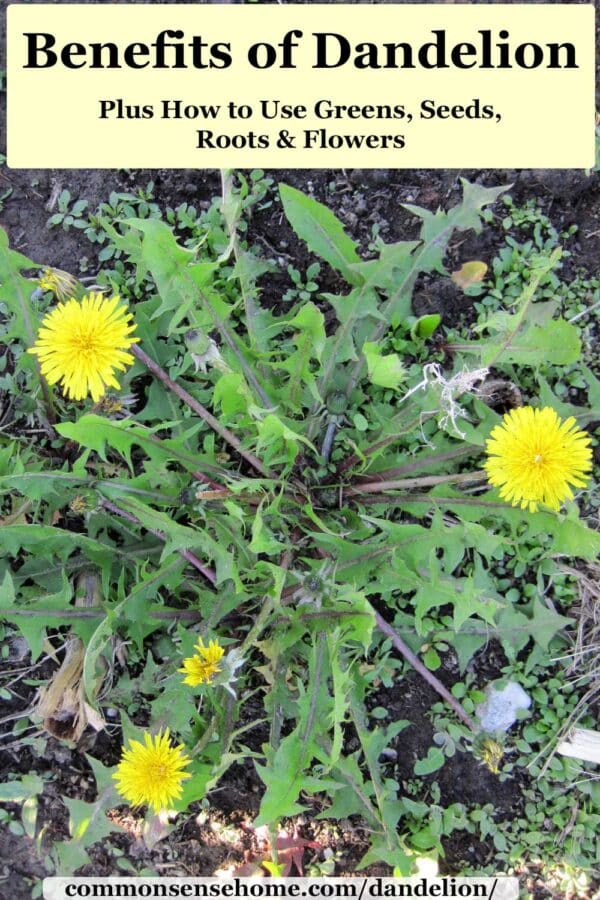
What does Dandelion Mean?
The name of Common Dandelion, Taraxacum officinale, translates to dent-de-lion in French, meaning “the lion’s tooth”.
It is also known as Piss-in-bed, wet-a-bed, (for the diuretic properties), blow ball, puffball (from the seed heads), fortune teller, doonheadclock, tell-time, clock flower, bitterwort, yellow gowan, swine snort (the closed blossoms look like a pig snout), Irish daisy, priest’s crown, cankerwort and other names around the world.
Range and Identification of Common Dandelion
Dandelions are Eurasian natives, but now found throughout the United States and much of the world. Their bright yellow flowers are some of the first to show in spring, as many a mother can testify, having been presented with dandelion bouquets.
The “flower” head is a composite of many tiny flowers clustered together, making it a wonderful plant for pollinators.
The leaves form a basal rosette, and are deeply loped with pronounced teeth. Plants range from a few inches high to over a foot tall, depending on growing conditions. The stems are hollow and produce a milk-like, sticky sap. At maturity, the flower heads turn to a white puff ball, and release seeds that resemble tiny parachutes.
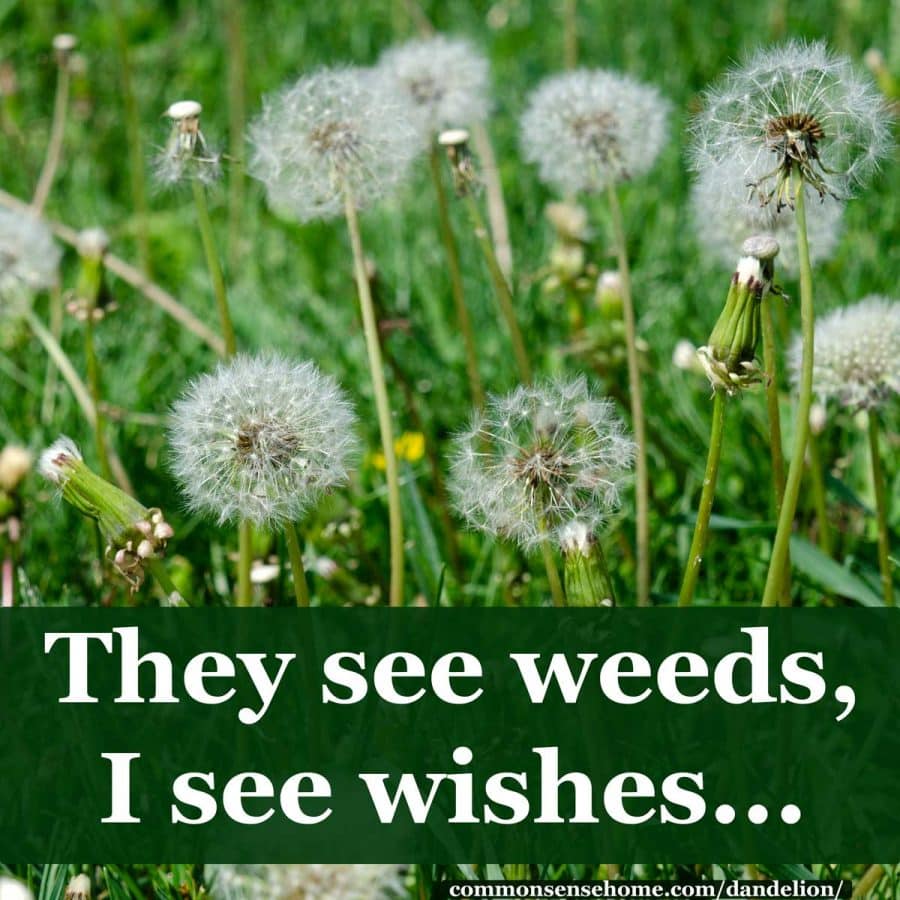
9 Potential Dandelion Benefits
In this section, we’ll discuss some common uses of dandelion. NOTE: Never collect plants for food or medicine from areas that have been sprayed with herbicides or other chemicals.
1. Nutrient Dense People Chow
What does dandelion do for your body?
First up, if you eat it like a veggie, it’s a very nutritious veggie. The leaves are loaded with vitamins and minerals, including the anti-oxidant beta carotene. (See below.)
Dandelion roots are high in inulin, a soluble fiber that acts as a probiotic, feeding good gut bacteria.
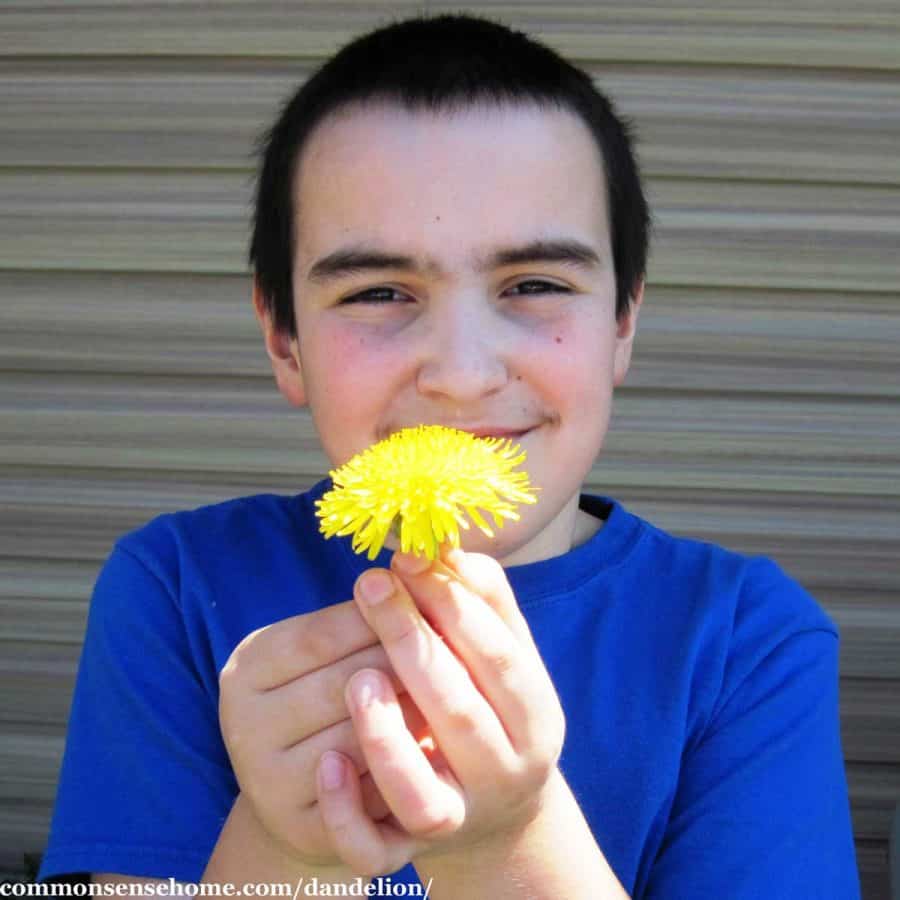
2. Digestive Aid
The bitterness of dandelion increases stomach acid, improving digestion. (Contrary to popular belief, acid reflux is often due to inadequate stomach acid.) Dandelion acts as a cholagogue, increasing flow of bile from the gallbladder into the duodenum. It also acts as a choleretic, increasing bile production.
You can try some dandelion tea before meals, or steeping some chopped greens in white wine to accompany your meal, or add the greens to your salad.
3. Mild Laxative
The inulin of dandelion roots helps to bulk up stool, while the potassium and magnesium in the leaves may help relieve bloating and constipation. (Constipation is commonly associated with potassium and magnesium deficiencies.)
4. Skin Freshener
Use dandelion flowers to lighten freckles and age spots, relieve sunburn and tighten pores. In Healing Wise, Susun Weed suggests covering freshly picked dandelion blossoms in boiling water. Cover your container and let steep for one hour. Strain and reserve liquid.
Place warm flowers on your target skin areas, and relax for ten minutes. Remove flowers and rinse with the flower liquid. Treat before bedtime and leave the dandelion water residue on overnight for best results.
5. Wart Remover
Apply the sap from the flower stalk directly to warts, calluses corns and rough skin. Rub in and repeat as needed. (The sap is antimicrobial.)
6. Help Regulate Blood Sugar
Is dandelion good for diabetes?
Initial studies say “yes”, dandelion may be helpful for regulating the blood sugar of type 2 diabetics. Volunteers in a 2016 study who consumed 5 g of dandelion root and leaf powder for nine days significantly reduced their fasting blood glucose levels
This may be because dandelion contains a source of levulin, which allows the liver to convert fructose in glycogen without insulin secretion. (From The Wild Wisdom of Weeds: 13 Essential Plants for Human Survival.)

7. Liver Tonic
Dandelion has a long history of use as a liver tonic. Studies, though limited, suggest they provide a range of hepaprotective effects, including:
- Antioxidant effect – reducing oxidative stress
- Antifibrotic effects – promoting regression of fibrosis
- Antisteatotic effect – Taraxacum officinale has been linked to improvement in fatty liver disease symptoms
- Anticancer activity
Dandelion is also know for its diuretic effect, clearing excess water weight without depleting potassium like many commercial diuretics.
8. Soothe Sore Muscles and Joints
Infuse dandelion flowers in oil to make an ointment for sore muscles, stiff joints or dry skin. Gather enough blossoms to fill a jar, and cover with olive oil. Infuse for a week or two and then strain. See How to Infuse Herbs for more detailed instructions.
9. Reduce Cancer Risk/Growth
Long used as a general tonic and treatment for chronic illness, recent studies show that dandelion root extract (DRE) may be an effective and non-toxic anti-cancer alternative.
Side Effects and Interactions
Although generally considered safe, like any food/herb it may cause allergic reactions or contact dermatitis in some individuals. Dandelion is not recommend for use while on diuretics or antibiotics. Consult with your doctor before taking herbal supplements if you are on medications, or nursing or pregnant.
Would you like to save this?
Are Dandelions Edible?
Yes – they are edible from root to seed! Keep reading to see how to use each portion.

Dandelion Flowers
Many types of wildlife consume dandelion flowers, leaves and seeds. As an early nectar source, the flowers are vital to bees and other pollinators.
Dandelion flowers are useful for human food and medicine, too. We make wine and jelly each year. Dandelion wine is lovely – more like a very good brandy. (Get the wine recipe here and the jelly recipe here.)
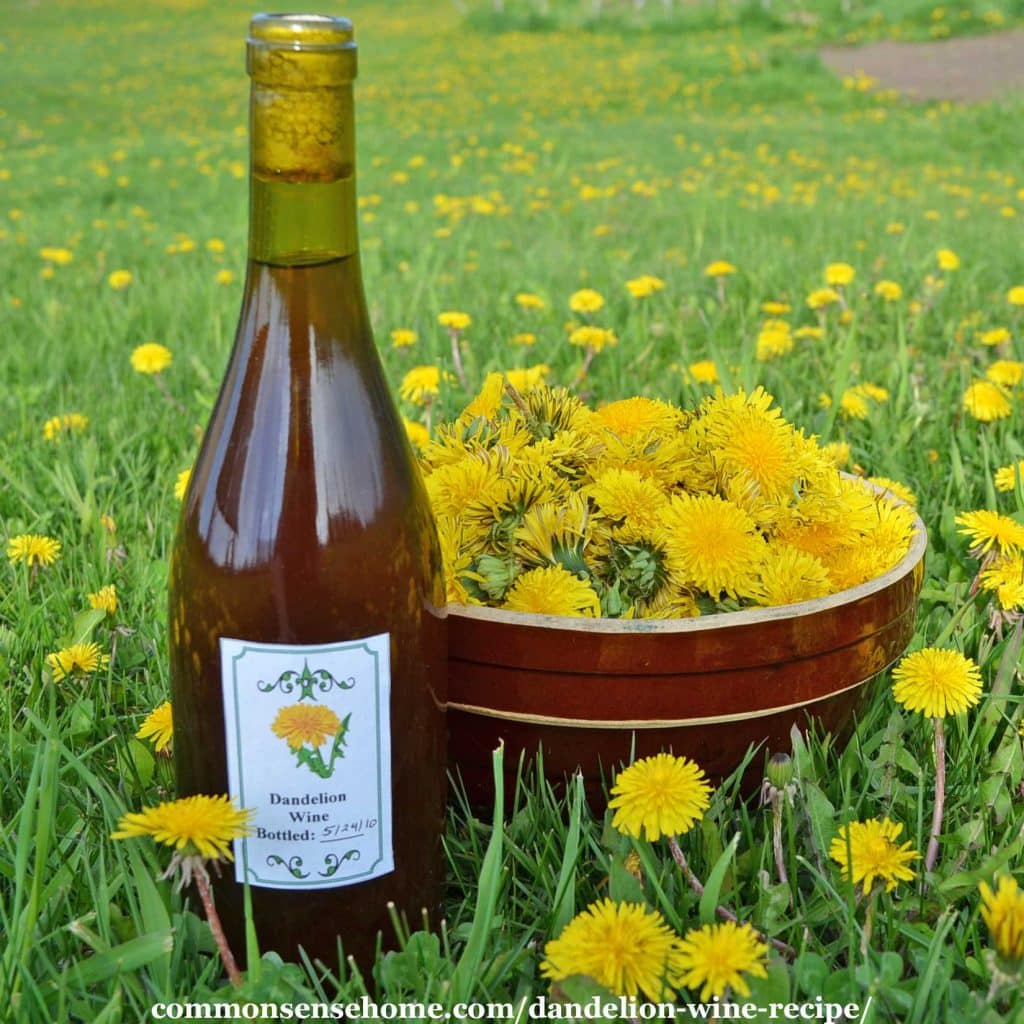
Add the flower petals to salads, breads or desserts, or dip and fry the whole blossoms like mushrooms.
Dandelion Greens
Dandelion greens are edible raw or cooked, although they are always somewhat bitter. They are best in spring, before the flowers bloom. As the season progresses, the leaves become more bitter. Plants growing in the shade or thick grass may be less bitter than those growing on open ground.
Dandelion leaves are one of the best natural sources of potassium, with 218 mg per cup of raw greens. They are also high in vitamins, A, C and K, as well as calcium, iron and magnesium.

Mix the greens with other spring greens in salads, or sauté with oil and seasonings. To reduce bitterness, boil for 10 minutes and pour off the water. (This will reduce some nutrients.) In recipes, use them like parsley or spinach.
The book Dandelion Medicine gives directions for biscuits, pesto, stir-fry and a host of other recipes. Healing Wise recipes include soups, dip and beer.
Rabbits enjoy the greens, as do many other farm animals such as goats, pigs and horses.
How to Store Dandelion Greens
Rinse and store fresh leaves in the refrigerator, as you would store other greens. You can keep them wrapped in a damp towel, or in a container.
Freeze for longer storage, or dehydrate or freeze dry. Use whole leaves in cooking or to make tea, or make your own green powder.
Dandelion Seeds
Dandelion seeds are edible, too. They can be nibbled off the white puffy parachute tops, or pinched off and gathering in quality to be made into seed milk. Katrina Blair explains making dandelion seed milk in her book, The Wild Wisdom of Weeds.
To obtain seeds for planting, gather them from the wild. For specific cultivated varieties, check out garden catalogs or order online.
Wild animals such as grouse, partridge, pheasant, quail, and wild turkey will enjoy the seed heads. Songbirds, such as blackbirds, goldfinches, sparrows, siskins, and towhees eat the seeds.
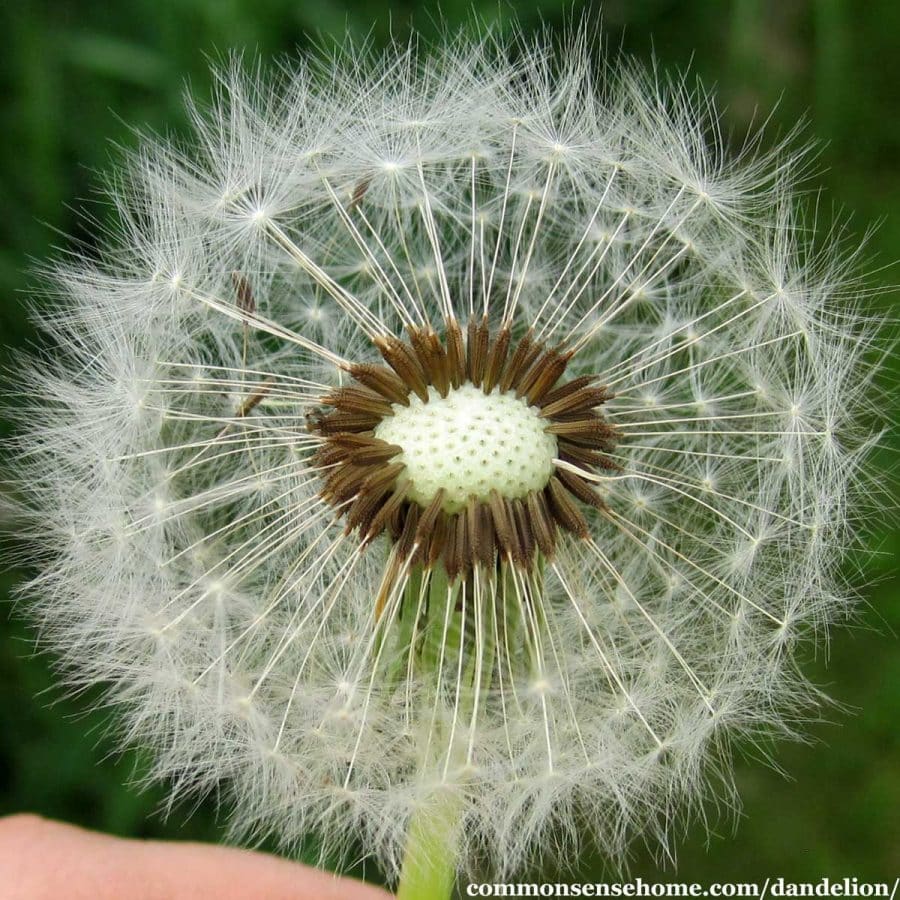
Dandelion Roots
Dandelion roots are edible and medicinal. You can dig them any time of year, but they are best for medicine in the fall, when the plant stores its energy in the roots.
For eating, first year roots are best. I like to Harvest them from the garden as I dig other root vegetables. Clean well and boil or roast like other root vegetables.
Root become tough and forked as they age – not great for eating. These roots make better medicine or herbal coffee. Dandelion coffee is a coffee substitute made from dried and roasted roots. Read more about harvesting and using dandelion roots here.)
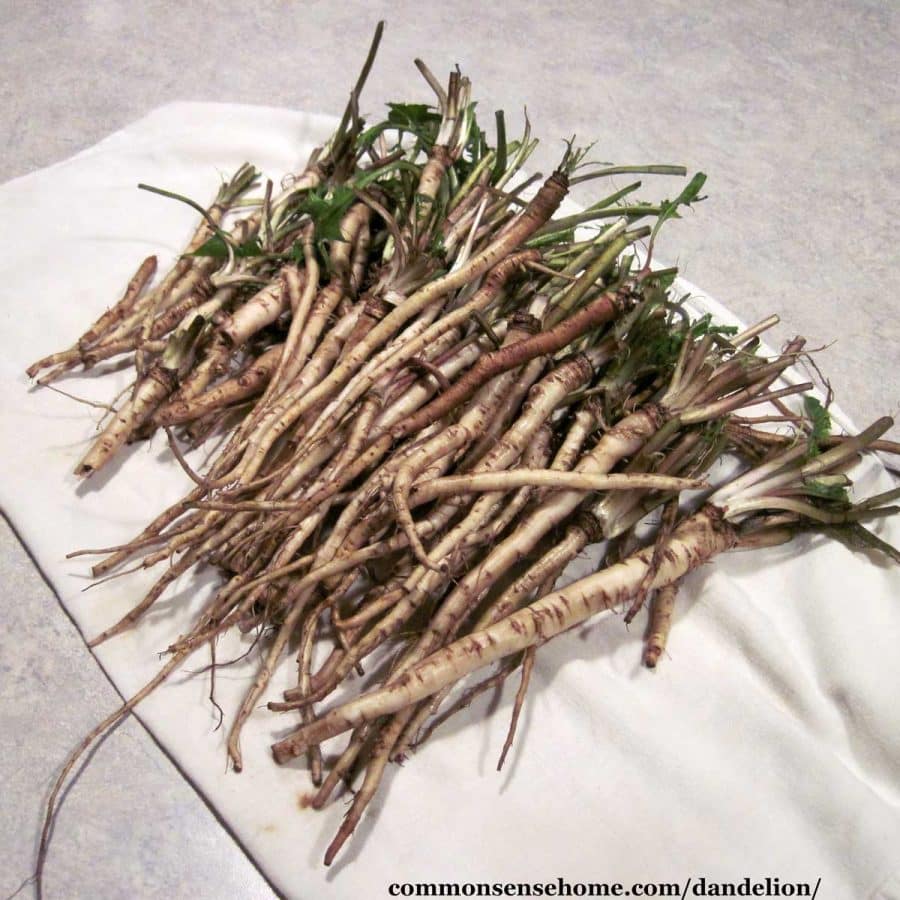
How to Get Rid of Dandelions
I love our bountiful, bright yellow flowers, but I understand that they are sometimes unwelcome. For instance, an online friend had a toddler who was allergic to bees and a yard full of blossoms. Not a great combination.
First, consider the health of your soil. Dandelions help heal battered soil, breaking up compaction with their deep tap roots. They also show up where soil calcium levels are low. Improve the soil, and they will more easily be replaced by other growth.
Work agricultural lime into the soil for fast action, or apply gypsum (Calcium Sulfate Dihydrate) for a slow growing but healthy lawn.
For spot removal, I prefer a hand held dandelion weeder. Look for a digger with a shallow notch at the tip, not a deep “V”. The roots slip right through the diggers with a deep “V”, but get grabbed by the shallow notch. (The deep “V” ones work lousy.)
Recommended Resources
This is Weekly Weeder #17. You may also enjoy other posts in the Weekly Weeder Series and Herbs and Wildcrafting, including:
- Recommended Wildcrafting Reference Books – Weekly Weeder #1
- Herbal Antibiotics – the Top 15 Herbal Antibiotics
- Stevia Plant – How to Grow it and Use it for Extract and More
For more in depth plant studies, consider The Herbal Academy. They offer learn at your own pace research tools through The Herbarium, along with more structured options through online courses from beginner to advanced.

Related Dandelion Information
- Dandelion Wine Recipe (& the Mistake You Don’t Want to Make)
- Dandelion Jelly – Easy Flower Jelly Recipe with Less Sugar
- Stop the Dandelion Madness! Making Peace with Dandelions and Bees
Originally published in 2012, last updated in 2019.

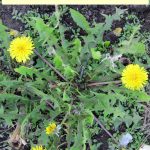
Thanks for sharing this important information.
As a beekeeper, I noticed that bees like the dandelion flowers a lot. I made a mistake of accidentally stepping on a flower that was being attended to by a bee, and guess what I got stung in the neck by the angry bee. I have decided to try and propagate the plants to another environment so as to provide forage for the bees. Iam harvesting the seeds and planting them. I dont know if its the best way .
That’s interesting. Our honeybees weren’t overly interested in the dandelions, but I’m not sure what they were eating at that time because the would disappear each day and I only spotted a few of them in the yard. We have many fruit trees and lots of wild and semi wild areas nearby, so they have a range of forage. The bumblebees enjoy dandelions quite a bit.
I love this post..
Will dandelion salve stain the skin? If no why not?
It shouldn’t. After infusion, there isn’t that much color carried along. Dandelions themselves don’t tend to stain the skin easily, not like turmeric or blueberries.
Your dandelion wine recipe is the best, next to figure out how the roots make coffee 🙂
Glad you like the wine. 🙂 Once the ground thaws. I’m going to try and find some roots and attempt to video a tutorial on the coffee.
Great read! We welcome the dandelions in our yard!
Thanks! The birds are singing and it sounds like spring outside, even though we are still covered in snow here.
I had some dandelions growing on a small “compose pile” (basically a pile of weeds behind the garage…lol) that had to be over a foot tall. The stems were huge. Never such large ones.
I remember as a child my parents would take us out for a drive, in the farmlands… They had big black garbage backs, with little knifes, for picking dandelions,, We would run around playing of course, while they were hard at work… My mother always prepared them by cleaning, and washing them really well. Then she would boil them for 15 minutes. Drain them, and serve them either hot or cold. with olive oil.. lemon, and salt… She would freeze the rest in zip lock bags, ( without the oil, and stuff.. ) and use the during the winter.. Now they sell them in grocery stores, so we don’t have to go looking for them.. although she still does.. 🙂
The gathering is part of the experience – and rather fun. 🙂
I would like to know more about preparing them. They are pretty dirty and once I wash them off, flowers, stems and leaves, the flowers are sticky little wads. Before, I’ve just mixed them with mustard and had a sandwich or something similar.
Mostly I use them as salad greens, or saute lightly and serve as cooked greens. I also make dandelion wine, and dry the roots for tea and coffee, and medicinal use. Don’t boil the flower stems and eat them like noodles. I read about that on another blog and tried it. It was revolting. Current dandelion posts on the site can be found here – https://commonsensehome.com/wildcraftingweekly-weeder/#Dandelions
Growing up in central PA in the late ’50s and early ’60s my brothers and I helped our mom dig up dandelion crowns for her to cook in late Feb and early Mar. They were served with bacon and a white sauce usually with slices of hardboiled eggs from our own flock. The biggest health benefit was to keep three active youngsters out of her hair for hours while she did the bookkeeping for Dad’s building and remodeling business.
David, that’s great!
This is so interesting. My son was picking some dandelions the other day and I was telling him that I know they are used for different things, but was not sure what.
Now you have some ideas to get you started. 🙂 I was just eying up some greens near our woodpile this morning, thinking I need to try more recipes this week.
My favorite way to serve dandelions is sweet and sour dandelions. I modified it from a cabbage recipe. You just wilt the greens along with some onions in a few tablespoons of cider vinegar and add a sprinkle of sugar. When the vinegar is almost all evaporated, dump the greens into a bowl and add olive oil and a sprinkle of salt. Absolutely delicious, and not bitter at all.
Thanks, Sheila!
I love your pictures and am very jealous of your dandelion forage. Mmm! We have very rocky soil where I live so digging one dandelion root is an insane amount of work–though once obtained we treasure it:) Thanks for the pingback. I’ll be looking into that Blog Hop business.
Try growing them in a raised bed
I think those are some really interesting names for dandelion. I actually have some dandelion root in my cupboard. A friend gave it to me. I use it for dandelion root coffee. It’s a really nice alternative…and dandelion is great for liver support. It’s also a natural diuretic!!! Love and hugs from the ocean shores of California, Heather 🙂
Thanks for sharing. The dandelions just started popping up in my yard and I am anxious to try some things with them.